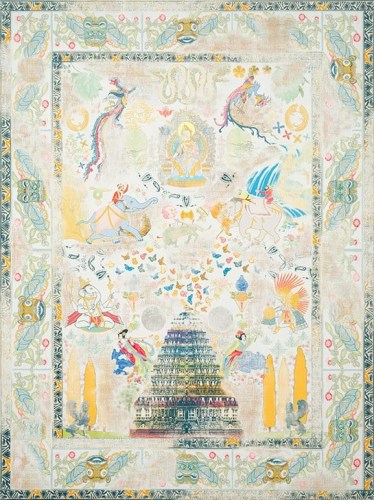
Kour Pour Future Buddha, 2014-2015
ART + EXHIBITIONS
Kour Pour’s First Solo Exhibition Opens
AD chats with Kour Pour as he prepares for the debut of his first solo show in Los Angeles
By
Michael Slenske
December 31, 2014
Growing up in southwestern England, Kour Pour got an early education in textiles from his Iranian-born father, who owned a carpet shop during the late 1980s. “They were always around,” says the artist, who has incorporated his intimacy with woven materials into his own work. Pour, now based in Los Angeles, made the first of his paintings of traditional carpets for his college graduation show using found images from museum and auction catalogues of Oriental rugs.
“I was thinking about the carpet and its role in the world as an object of craft—people weaving in a community, the history, the patterns, the figures, and even its place as a commodity being traded,” he says. “[Carpets] are also an iconic image that everyone recognizes, so I was attracted to it for those reasons and personal ones.”
Thanks to the power of Instagram, sold-out shows at New York’s Untitled gallery and Dublin’s Ellis King, and Pour’s relationship with the controversial art dealer Stefan Simchowitz, his works have become hotly traded commodities in their own right. “It’s the cycle that I’m interested in,” says Pour. “For the early paintings I made, I would find the images from Sotheby’s catalogues, and now those paintings are starting to show up at auction, so that carpet has gone from being a real carpet to a photograph to a painting back to a photograph, and now it’s in a contemporary art sale. Things transform over time; they become new things with different meanings.”
Rather than shy away from the drama of the art market, Pour is jumping right into the fire with his Los Angeles solo debut, “Samsara,” at West Hollywood’s Depart Foundation. Whereas the screen prints of his early works were entirely painted over by hand, the six paintings in this new show leave some traces of the screens, drawing parallels between hand-knotted carpets with artisan dyes and factory-made rugs with artificial colors.
This time around, Pour has also created all of the imagery himself via clip art and Google search elements—Kama Sutra illustrations, butterflies, Egyptian figures—which are stored on CD-ROMs and Photoshopped into various tableaux. “I could make them very narrative and tell a specific story, but it’s not what I’m interested in,” says Pour. “I’ll type in ‘Japanese mythology’ or ‘ancient Buddhist temples’ and time-travel from place to place and put it into this format where past, present, and future are all rolled into one. They’re records of the way we collect information, and it’s also about taking these images out of their original context.”
To further tweak the notion of art as commodity, Pour is installing a wall in the gallery’s back room of seven 14-foot-tall panels flocked with golden powdered incense titled Light Will Someday Split You Open, which will stand opposite piles of burnt black incense. “I'm interested in the ceremonial aspect of it, but it's also very minimal—and that,” Pour says, pointing to the front room of paintings, “is very maximal.” Entering the back room is almost an act of purification; the ashes, he says, are death. Visitors will exit the space the same way they came in—a rebirth, Pour says, so “you look at the paintings differently than you did when you entered.”
"Samsara," through March 7 at Depart Foundation, 9105 W. Sunset Blvd, Los Angeles; departfoundation.com